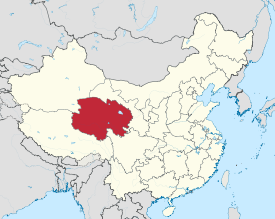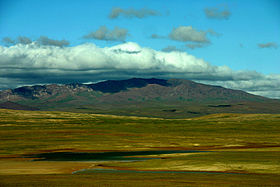Qinghai
青海 | |
|---|---|
| Province of Qinghai | |
| Name transcription(s) | |
| • Chinese | 青海省 (Qīnghǎi Shěng) |
| • Abbreviation | QH / 青 (pinyin: Qīng) |
Clockwise from the top:
| |
 Map showing the location of Qinghai Province | |
| Coordinates: 35°N 96°E / 35°N 96°E | |
| Country | China |
| Named for | Derived from the name of Qinghai Lake ("blue/green lake"). |
| Capital (and largest city) | Xining |
| Divisions - Prefecture-level - County-level - Township- level | 8 prefectures 44 counties 404 towns and subdistricts |
| Government | |
| • Body | Qinghai Provincial People's Congress |
| • CCP Secretary | Chen Gang |
| • Congress Chairman | Chen Gang |
| • Governor | Wu Xiaojun |
| • Provincial CPPCC Chairman | Gönbo Zhaxi |
| • National People's Congress Representation | 24 deputies |
| Area | |
• Total | 720,000 km2 (280,000 sq mi) |
| • Rank | 4th |
| Highest elevation | 6,860 m (22,510 ft) |
| Population (2020)[2] | |
• Total | 5,923,957 |
| • Rank | 31st |
| • Density | 8.2/km2 (21/sq mi) |
| • Rank | 30th |
| Demographics | |
| • Ethnic composition | Han – 54% Tibetan – 21% Hui – 16% Tu – 4% Mongol – 1.8% Salar – 1.8% |
| • Languages and dialects | Zhongyuan Mandarin Chinese, Amdo Tibetan, Monguor, Oirat Mongolian, Salar and Western Yugur |
| GDP (2023)[3] | |
| • Total | CN¥ 379,906 million (30th)
US$ 53,913 million |
| • Per capita | CN¥ 63,903 (24th)
US$ 9,069 |
| ISO 3166 code | CN-QH |
| HDI (2022) | 0.719[4] (30th) – high |
| Website | www |
| Qinghai | |||||||||||||||||||||||||||||||||||||||
|---|---|---|---|---|---|---|---|---|---|---|---|---|---|---|---|---|---|---|---|---|---|---|---|---|---|---|---|---|---|---|---|---|---|---|---|---|---|---|---|
"Qinghai" in Chinese characters | |||||||||||||||||||||||||||||||||||||||
| Chinese name | |||||||||||||||||||||||||||||||||||||||
| Chinese | 青海 | ||||||||||||||||||||||||||||||||||||||
| Postal | Tsinghai | ||||||||||||||||||||||||||||||||||||||
| Literal meaning | "Qinghai (Lake)" | ||||||||||||||||||||||||||||||||||||||
| |||||||||||||||||||||||||||||||||||||||
| Tibetan name | |||||||||||||||||||||||||||||||||||||||
| Tibetan | མཚོ་སྔོན། | ||||||||||||||||||||||||||||||||||||||
| |||||||||||||||||||||||||||||||||||||||
| Mongolian name | |||||||||||||||||||||||||||||||||||||||
| Mongolian Cyrillic | Хөхнуур | ||||||||||||||||||||||||||||||||||||||
| Mongolian script | ᠬᠥᠬᠡ ᠨᠠᠭᠤᠷ | ||||||||||||||||||||||||||||||||||||||
| |||||||||||||||||||||||||||||||||||||||
| Manchu name | |||||||||||||||||||||||||||||||||||||||
| Manchu script | ᡥᡠᡥᡠ ᠨᠣᠣᡵ | ||||||||||||||||||||||||||||||||||||||
| Romanization | Huhu Noor | ||||||||||||||||||||||||||||||||||||||
| Oirat name | |||||||||||||||||||||||||||||||||||||||
| Oirat | Kokonur | ||||||||||||||||||||||||||||||||||||||
Qinghai[a] is an inland province in Northwestern China. It is the largest province of China (excluding autonomous regions) by area and has the third smallest population. Its capital and largest city is Xining.
Qinghai borders Gansu on the northeast, Xinjiang on the northwest, Sichuan on the southeast and the Tibet Autonomous Region on the southwest. Qinghai province was established in 1928 during the period of the Republic of China, and until 1949 was ruled by Chinese Muslim warlords known as the Ma clique. The Chinese name "Qinghai" is after Qinghai Lake, the largest lake in China. The lake is known as Tso ngon in Tibetan, and as Kokonor Lake in English, derived from the Mongol Oirat name for Qinghai Lake. Both Tso ngon and Kokonor are names found in historic documents to describe the region.[7]
Located mostly on the Tibetan Plateau, the province is inhabited by a number of peoples including the Han (concentrated in the provincial capital of Xining, nearby Haidong, and Haixi), Tibetans, Hui, Mongols, Monguors, and Salars. According to the 2021 census reports, Tibetans constitute a fifth of the population of Qinghai and the Hui compose roughly a sixth of the population. There are over 37 recognized ethnic groups among Qinghai's population of 5.6 million, with national minorities making up a total of 49.5% of the population.
The area of Qinghai came under the control of the Manchu-led Qing Dynasty around 1724, after their defeat of Khoshut Mongols who previously controlled most of the area. After the Xinhai Revolution and the ensuing fall of the Qing dynasty in 1912, Qinghai came under Chinese Muslim warlord Ma Qi's control until the Northern Expedition by the Republic of China consolidated central control in 1928. In the same year, the province of Qinghai was established by the Nationalist Government, with Xining as its capital.[8][9][10]
- ^ "Qinghai Province". Qinghai Province Department of Commerce. Archived from the original on 4 March 2016. Retrieved 5 August 2013.
- ^ "Communiqué of the Seventh National Population Census (No. 3)". National Bureau of Statistics of China. 11 May 2021. Retrieved 11 May 2021.
- ^ "National Data". China NBS. March 2024. Retrieved June 22, 2024. see also "zh: 2023年青海省国民经济和社会发展统计公报". qinghai.gov.cn. February 29, 2024. Retrieved June 22, 2024. The average exchange rate of 2023 was CNY 7.0467 to 1 USD dollar "Statistical communiqué of the People's Republic of China on the 2023 national economic and social development" (Press release). China NBS. February 29, 2024. Retrieved June 22, 2024.
- ^ "Human Development Indices (8.0)- China". Global Data Lab. Retrieved 23 September 2024.
- ^ "Qinghai". Lexico UK English Dictionary. Oxford University Press. Archived from the original on May 18, 2021.
- ^ 中国地名录 (2nd ed.). Beijing: China Maps Press. 1995. p. 309. ISBN 7-5031-1718-4.
- ^ Gangchen Khishong, 2001. Tibet and Manchu: An Assessment of Tibet-Manchu Relations in Five Phases of Development. Dharmasala: Narthang Press, p.1-70.
- ^ "中華民國政府令". 國民政府公報. Vol. 93. Republic of China: 國民政府秘書處. Sep 1928. p. 5.
- ^ "中華民國十七年十月十九日 中華民國政府令". 國民政府公報. No. 2. Republic of China: 國民政府文官處印鑄局. 27 Oct 1928. p. 9.
- ^ "中華民國十八年一月二十九日 國民政府指令一八九號". 國民政府公報. No. 80. Republic of China: 國民政府文官處印鑄局. 31 Jan 1929. pp. 8–9.
Cite error: There are <ref group=lower-alpha> tags or {{efn}} templates on this page, but the references will not show without a {{reflist|group=lower-alpha}} template or {{notelist}} template (see the help page).




